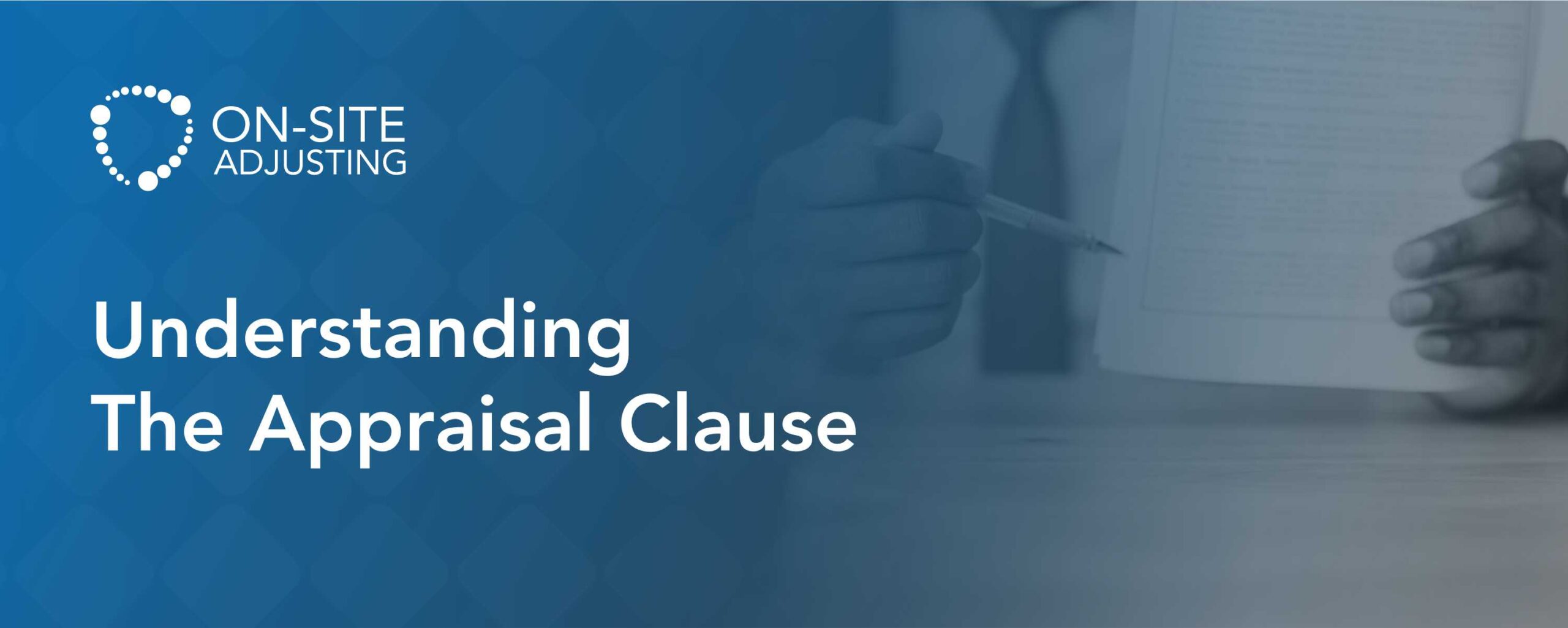
The appraisal clause often appears in insurance policies, particularly in property damage cases. Its sole purpose is to resolve disputes between policyholders and insurers relating to the amount of a loss. Hiring a public adjuster can also make the appraisal process easier for you.
In this article, we will take you through everything you need to know about the appraisal clause. You will understand what the clause entails, what to expect during the appraisal process, and why you should or shouldn’t invoke it.
What is the Appraisal Clause?

The appraisal clause is a provision in insurance policies that allows either the insurer or the policyholder to demand an independent appraisal of the claimed loss. It is only used when there is a disagreement on the amount of the loss. This clause is most commonly found in property insurance policies. Generally, it can be invoked when both parties cannot agree on the value of the damaged property.
Key Elements of the Appraisal Clause
Dispute Trigger
The appraisal clause is typically triggered when there is a disagreement over the amount of the claim. This means that either the policyholder or the insurer believes that the amount being offered is not accurate or fair.
Independent Appraisers
Both the policyholder and the insurer then select an impartial appraiser. This means that the chosen appraisers must have zero prior involvement in the claim. They must also not have any vested interest in the outcome of the claim. This will ensure that they will be objective and fair in their appraisal.
Umpire
If the two appraisers cannot agree on the amount of the loss, they will select a neutral umpire. The umpire acts as a third party and will review the assessments before making a final decision. This will only happen if the appraisers’ opinions are significantly different.
Binding Decision
The decision reached through the appraisal process is usually binding on both parties. This means that once the appraisers (or the umpire, if needed) have determined the amount of the loss, both the insurer and the policyholder must accept this decision and settle the claim accordingly.
Feeling stuck with your claim? You don’t have to fight alone.
Reach out to us — we will review your claim for free and help you understand your options
Benefits of the Appraisal Clause
Invoking the appraisal clause can offer several advantages, some of which are:
Fair Resolution
The primary benefit is achieving a fair and unbiased resolution of the dispute. This is why the appraisers must be independent and impartial in their assessment. It will both parties get a fair evaluation and resolution.
Cost-Effectiveness
Compared to litigation, the appraisal process is generally less expensive. It helps parties to avoid the high costs associated with court fees, attorney fees, and prolonged legal battles.
Time-Saving
The appraisal process is usually faster than going through the court system. It can speed up the resolution which allows policyholders to receive their settlement and begin repairs or replacements sooner.
Expertise
Appraisers are typically experts in the field of property valuation and damage assessment. Their expertise can lead to a more accurate and fair determination of the loss amount.
Downsides of the Appraisal Clause
While there are significant benefits, there are also some drawbacks you should consider before invoking the appraisal clause:
Potential Costs
Although less expensive than litigation, the appraisal process can still be costly. Both parties must pay for their chosen appraiser, and if an umpire is needed, the costs can increase.
- Binding Decision
The appraisal decision remains binding no matter how the policyholder feels. This can be a downside if the policyholder is unsatisfied with the decision. Once the decision is made, there is little room for further negotiation or appeal.
Complexity
The appraisal process can be complex and intimidating for policyholders who are going through it for the first time. Understanding the technicalities and selecting a competent appraiser can be challenging.
- Limited Scope
The appraisal clause typically only addresses the amount of loss. Other issues like coverage disputes are usually ignored. If there are other disagreements, the appraisal clause may not resolve them.
When to Invoke the Appraisal Clause
Deciding when to invoke the appraisal clause depends on the specific circumstances of the dispute. It is best to enforce it when there are:
Significant Discrepancies
Invoking the appraisal clause can help bridge the gap where there is a huge difference between the policyholder’s estimate and the insurer’s offer. For example, if the policyholder believes that the insurer’s adjuster’s estimate will not be enough to repair the damage.
- Failed Negotiations
The appraisal clause can provide a way forward where there is a deadlock. A deadlock refers to a situation where no progress can be made. It usually occurs when both parties have had multiple discussions but there has been no headway.
Expert Disagreement
The experts introduced through the appraisal process can provide more accurate resolutions. This is often the case with specialized or extensive damage that requires detailed evaluation by professionals.
The Appraisal Process

Understanding the appraisal process can demystify it and help you navigate it more effectively. Here is what a typical appraisal process looks like:
Step 1: Demand for Appraisal
Either the policyholder or the insurer can initiate the process by demanding an appraisal in writing. This is typically done after negotiations have failed. The written demand should clearly state the disagreement and request the initiation of the appraisal process.
Step 2: Selection of Appraisers
Both parties select their appraisers. These appraisers must be impartial and competent. Each party bears the cost of their appraiser. It is crucial to select appraisers with the right qualifications and experience relevant to the type of damage and property involved.
Step 3: Independent Evaluation
The appraisers independently assess the damage and determine the value of the loss. They will review the evidence, inspect the property, and possibly consult with other experts. This step involves a detailed examination of the property. This examination will include reviewing repair estimates, photos, and other relevant documentation.
Step 4: Agreement or Disagreement
The appraisers will then try to agree on the amount of the loss. If they agree, the agreed amount becomes the final value. This agreement is typically documented in a written report that explains how the value was determined.
Step 5: Selection of an Umpire
If the appraisers cannot agree, they will select an umpire. If they cannot agree on an umpire, a court can appoint one. The umpire serves as a neutral third party who reviews the appraisers’ findings and makes a final decision if necessary.
Step 6: Umpire Decision
The umpire reviews the appraisers’ assessments and makes a final decision. This decision is binding on both parties. The umpire’s decision is documented and provided to both the insurer and the policyholder, finalizing the amount of the loss.
How to Choose an Appraiser

Choosing the right appraiser is critical to ensuring a fair and accurate appraisal process. Here are some qualities you should consider when making your decision:
Qualifications and Experience
You should opt for appraisers who have relevant qualifications and experience in property valuation and damage assessment. They should be familiar with the type of damage involved and have a good track record. Check for certifications, professional memberships, and any specialized training that may be relevant.
- Impartiality
Ensure the appraiser is impartial and does not have any conflicts of interest. They should not have any prior relationship with either party that could make their settlement biased. It’s important to vet their background and ensure they have no connections to the insurance company. They should have no reason to be personally invested in the outcome of the process.
Reputation
Check the appraiser’s reputation by looking at reviews, testimonials, and professional references. A well-respected appraiser is more likely to provide a fair and accurate evaluation. Ask for recommendations from trusted sources such as friends, family, and colleagues or consult professional organizations for referrals.
Communication Skills
Choose an appraiser who can clearly explain their findings and reasoning. Good communication is essential for understanding the appraisal process and the final decision. They should be able to articulate complex valuation issues in a way that is understandable to both parties.
What Happens When Appraisers Cannot Agree?
Disagreements between appraisers are not uncommon. Usually, the first step is to involve the umpire. The umpire acts as a neutral third party and reviews the evidence provided by both appraisers. The umpire’s decision is final and binding.
However, if the appraisers cannot agree on an umpire, a court can be asked to appoint one. This ensures the appraisal process continues even when there is a stalemate. The court-appointed umpire will then review the case and make a final decision.
Once the umpire makes a decision, it is binding on both parties. This means that both the policyholder and the insurer must accept the umpire’s determination of the loss amount.
The insurance company will then adjust the claim amount based on the appraisal outcome. This typically results in a final resolution of the dispute. The policyholder will receive the agreed amount and then proceed with repairs or replacements.
Conclusion
The appraisal clause is an essential tool for resolving disputes over the amount of a loss in property damage claims. Understanding how it works, its benefits, and its potential drawbacks can help policyholders navigate the process more effectively. Policyholders can ensure they receive a fair and accurate settlement for their claims by knowing when to invoke the appraisal clause and how to choose a competent appraiser.
A public adjuster can help you better navigate the appraisal process to ensure that you get a favorable outcome. On-Site Adjusting has experienced professionals who will make the process hassle-free for you. Contact us today to take advantage of our free consultation.












